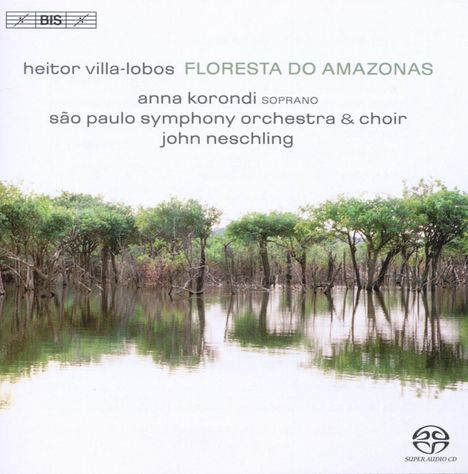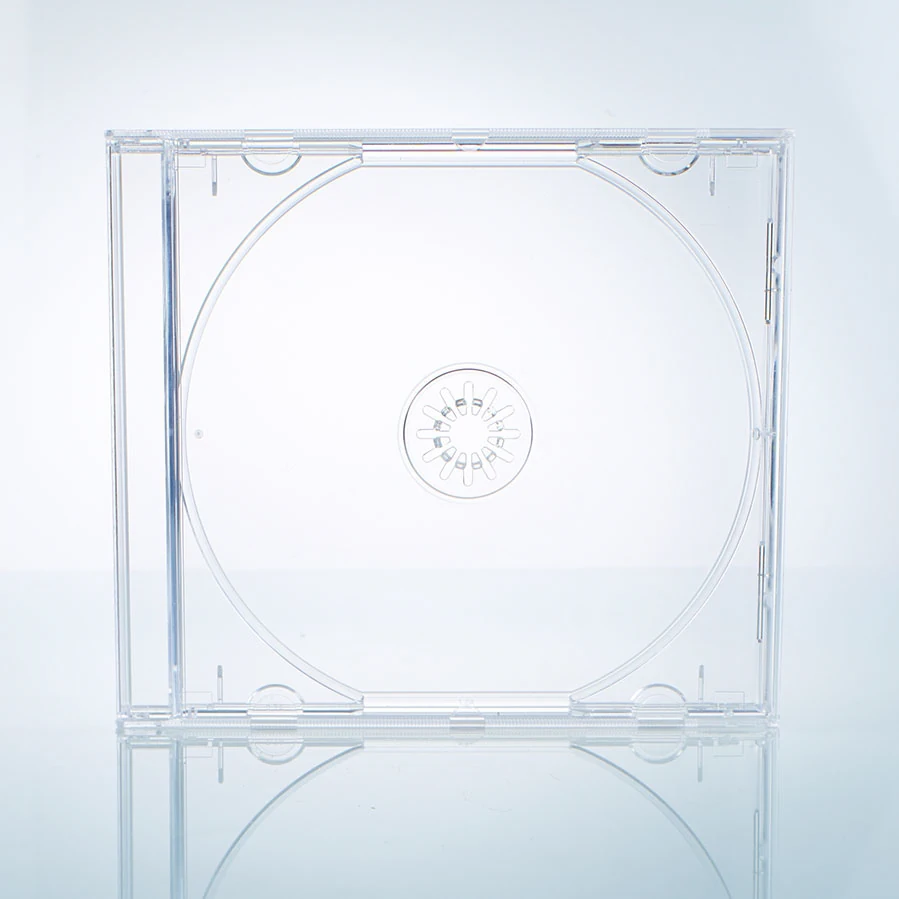Heitor Villa-Lobos: Floresta do Amazonas auf Super Audio CD
Floresta do Amazonas
Die SACD verwendet eine höhere digitale Auflösung als die Audio-CD und bietet außerdem die Möglichkeit, Mehrkanalton (Raumklang) zu speichern. Um die Musik in High-End-Qualität genießen zu können, wird ein spezieller SACD-Player benötigt. Dank Hybrid-Funktion sind die meisten in unserem Shop mit "SACD" gekennzeichneten Produkte auch auf herkömmlichen CD-Playern abspielbar. Dann allerdings unterscheidet sich der Sound nicht von einer normalen CD. Bei Abweichungen weisen wir gesondert darauf hin (Non-Hybrid).
Lassen Sie sich über unseren eCourier benachrichtigen, falls das Produkt bestellt werden kann.
- Tonformat:
- stereo & multichannel (Hybrid)
- Künstler:
- Anna Korondi, Sao Paulo State SO & Choir, John Neschling
- Label:
- BIS
- Aufnahmejahr ca.:
- 2009
- UPC/EAN:
- 7318599916606
- Erscheinungstermin:
- 23.6.2010
Ähnliche Artikel
Schon in einigen seiner frühesten Orchesterkompositionen (wie „Uirapuru“ von 1917) brachte Heitor Villa-Lobos seine Sorge um den Fortbestand des Regenwaldes zum Ausdruck. Auch in den „Choros“ Nr. 3 und 10 beschreibt er unberührte Wälder.
In „Floresta do Amazonas“, einem seiner letzten Werke, wendete er sich wiederum dem Regenwald zu, seinen Tieren und Mythen. Das Werk kann als symphonische Dichtung für Sopran, Männerchor und großes Orchester beschrieben werden.
Den Anstoß zur Komposition gab eigentlich der Auftrag, für einen Hollywood-Film mit Audrey Hepburn und Anthony Perkins die Musik zu schreiben. Villa-Lobos hatte da keine Erfahrung und hielt es nicht für nötig, die Musik mit dem Geschehen auf der Leinwand zu synchronisieren. Er kam deshalb mit einer fertigen (und unbrauchbaren) Partitur in Hollywood an. Und so musste ein anderer Komponist ran, der unter Verwendung von Material aus Villa-Lobos‘ Partitur eine neue Filmmusik schrieb. Der wiederum arbeitete seine Komposition zu dem hier eingespielten Werk um. Wobei einige der Lieder sehr populär wurden.
In some of his very first orchestral scores, such as Uirapuru from 1917, Heitor Villa-Lobos was already concerned with the vast Amazonian forests. The subject surfaces in a number of works throughout his production, for instance in the depictions of virgin forests in Choros No. 3 and No. 10. In Floresta do Amazonas, one of his very last works, Villa-Lobos again focused explicitly on the rain forest, the creatures that live in it, and the myths that have been woven around it. The work has been described as a symphonic poem for soprano, male-voice choir and large orchestra, and began its existence as a commission for the soundtrack to The Green Mansions, a Hollywood film starring Audrey Hepburn and Anthony Perkins. Not used to writing for the cinema, Villa-Lobos did not consider the need to synchronize the music with what was going to take place on the screen. He therefore arrived in Hollywood with a finished score, and eventually another composer was engaged to write the film music, in which some of Villa-Lobos' own themes were included. Villa-Lobos on the other hand used his score to create the work recorded here, and commissioned lyrics to the four songs which make up the substantial solo soprano part, together with the vocalises appearing in several movements. The songs, Melodia Sentimental in particular, have also become popular as separate concert items. The suite's twenty-three movements have rousing titles such as 'Forest Fire', 'Head Hunters' and 'Dance of the Indians', but also include numbers such as 'Lullaby' and 'Twilight'. This expansive fresco has now been recorded in a recent, revised edition, prepared by the Villa-Lobos specialist Roberto Duarte, who has also written the liner notes to the disc. The interpretation has been entrusted to John Neschling and the São Paulo Symphony Orchestra, a team which in a recent cycle of Villa-Lobos' complete Choros has proved its ability to paint Brazilian landscapes: 'Villa-Lobos' compatriots have managed to do his quirky genius full justice' wrote the website ClassicsToday. com while the French magazine Diapason awarded the cycle its prestigious Diapason d'Or de l'Année, designating it 'Artistic Project of 2009'.
Rezensionen
Stereoplay 01/11: "Mit Neschlings langsamen Tempi kommt die Klassizität der Musik mit ihren extravaganten Harmonien hervorragend zur Geltung. Die Männerstimmen des Chores der Staatssinfonie Sao Paulo singen die amazonischen Texte und indianischen Themen pointiert, homogen und zupackend. Anna Korondi gestaltet die liedhaften Passaagen mit vibrierender Leidenschaft, berückenden Kantilenen und großer Durchschlagskraft."Disk 1 von 1 (SACD)
Floresta do Amazonas
-
1 1. Ouverture
-
2 2. A Floresta (The forest)
-
3 3. Dança dos #ndios (Dance of the Indians)
-
4 4. Em Plena Floresta (In the depths of the forest)
-
5 5. Pássaro da Floresta: Canto 1 (Bird of the forest: First song)
-
6 6. Dança da Natureza (Nature's dance)
-
7 7. Pássaro da Floresta: Canto 2 (Bird of the forest: Second song)
-
8 8. Canta na Floresta 1 (Song in the forest 1)
-
9 9. Conspiraç#o e Dança Guerreira (Conspiracy and war dance)
-
10 10. Veleiros (Sailing ships)
-
11 11. Em Caminhos para a Caçada (On the way to the hunt)
-
12 12. Pássaro da Floresta: Canto 3 (Bird of the forest: Third song)
-
13 13. Cair da Tarde (Twilight)
-
14 14. Os #ndios em Busca da Moça (The Indians in search of the girl)
-
15 15. Pássaro da Floresta: Canto 4 (Bird of the forest: Fourth song)
-
16 16. Dança Guerreira: Repetiç#o (War dance: Repeat)
-
17 17. Interlúdio e Acalato (Interlude and lullaby)
-
18 18. Canto na Floresta 2 (Song in the forest 2)
-
19 19. Caçadores de Cabeça (Head hunters)
-
20 20. Canç#o do Amor (Love song)
-
21 21. Melodia sentimental (Sentimental melody)
-
22 22. O Fogo na Floresta (Forest fire)
-
23 23. Epílogo (Epilog)
Mehr von Heitor Villa-Lobos
-
Heitor Villa-LobosSämtliche Symphonien7 CDsAktueller Preis: EUR 39,99
-
Tilman Hoppstock - Great Preludes for GuitarCDAktueller Preis: EUR 6,99
-
Asya Fateyeva - BachianaCDAktueller Preis: EUR 19,99
-
Khatia Buniatishvili - LabyrinthCDVorheriger Preis EUR 19,99, reduziert um 0%Aktueller Preis: EUR 12,99











